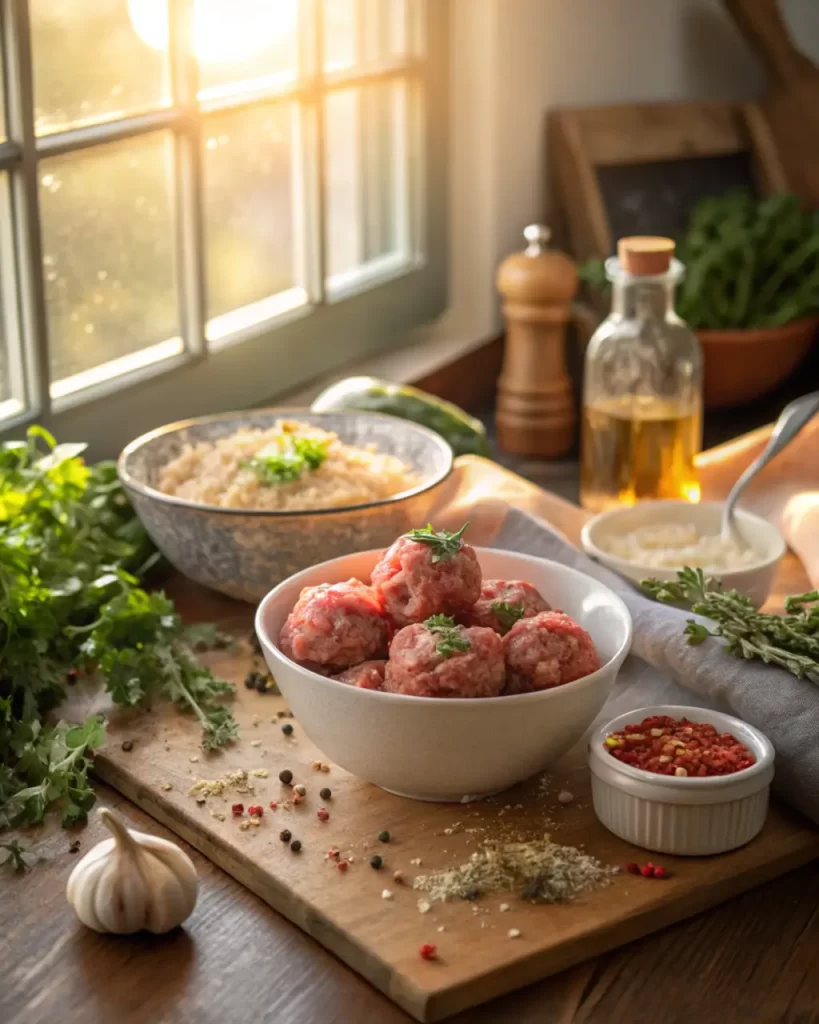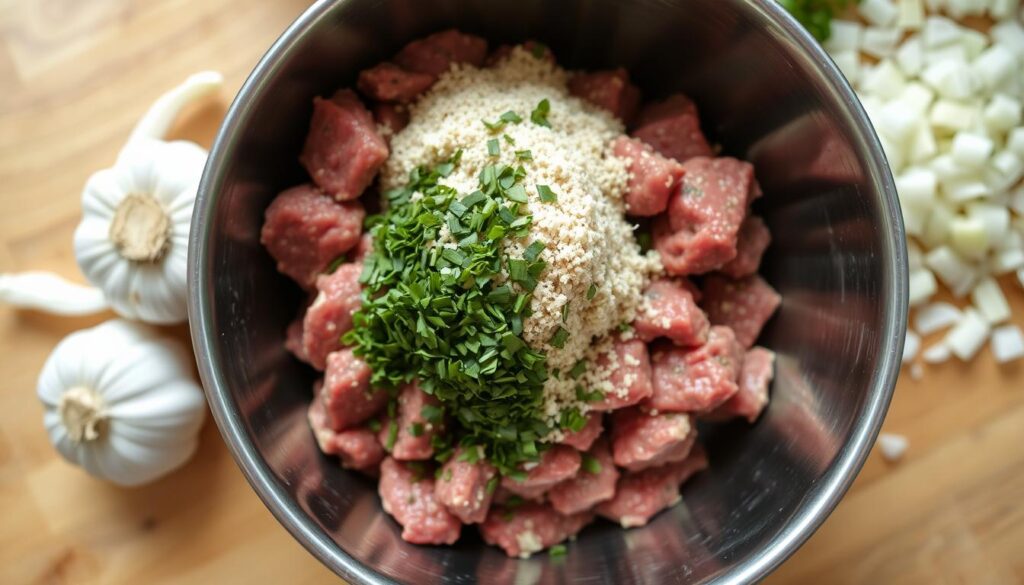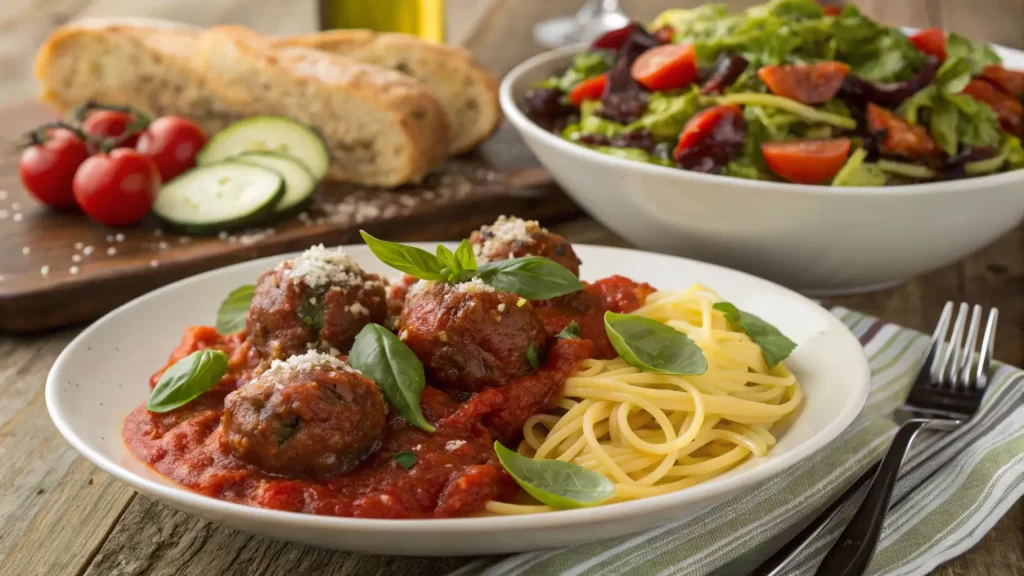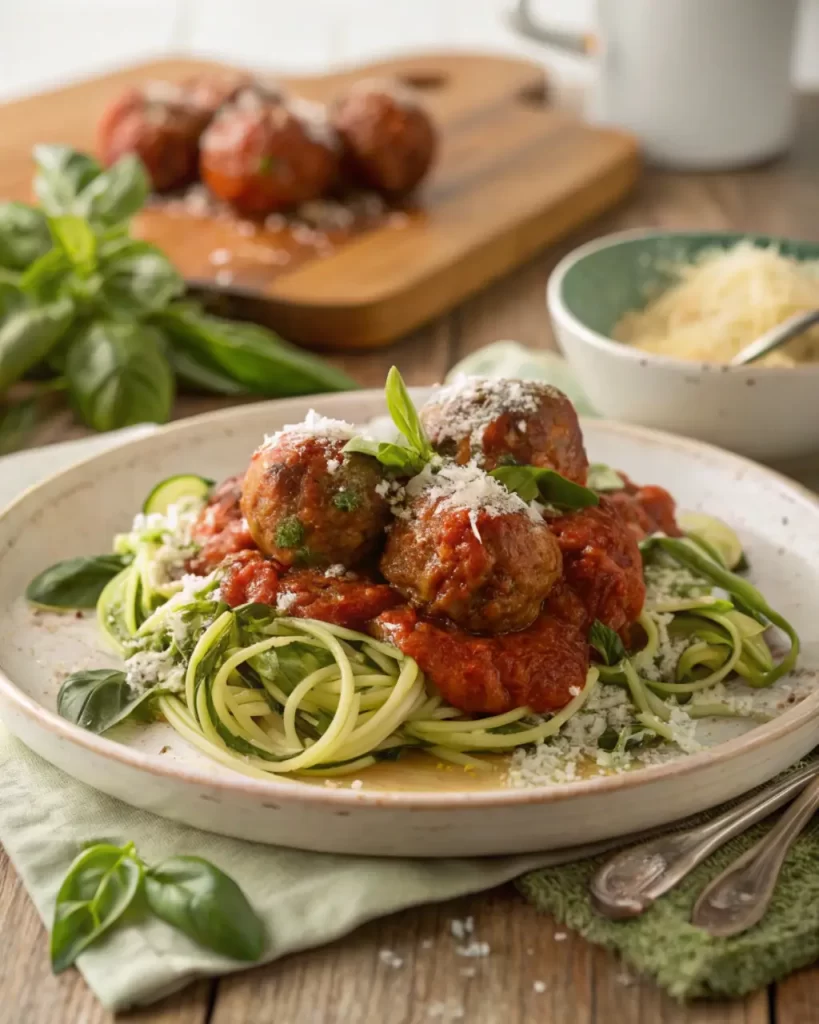Imagine walking into your kitchen and smelling the warm aroma of freshly baked meatballs. It’s like a cozy hug from home. With more people following gluten-free diets, finding tasty recipes can be a challenge. But, making gluten-free meatballs is simple and fulfilling.
These homemade meatballs are not only juicy but also packed with flavor. They’re ready in just 10 minutes to prep and 30 minutes to cook. Whether you’re having a big gathering or a cozy dinner, this recipe is perfect for all. Let’s explore how to make gluten-free meatballs that will wow everyone!
To complete the meal, consider adding a slice of our Delicious Gluten-Free Rye Bread or a refreshing Chicken, Kale, and Wild Rice Salad.
Table of contents
- Introduction to Gluten Free Meatballs
- Benefits of Homemade Gluten Free Meatballs
- Key Ingredients for Tender Gluten Free Meatballs
- Step-by-Step Guide to Making Gluten Free Meatballs
- Cooking Methods for Gluten Free Meatballs
- Pairing Suggestions for Gluten Free Meatballs
- Freezing and Storing Gluten Free Meatballs
- Delicious Sauce Recommendations for Meatballs
- Serving Ideas and Presentation Tips
- Versatile Variations of Gluten Free Meatballs
- Conclusion
- FAQ
- What makes gluten-free meatballs taste just as good as traditional meatballs?
- Can I use different types of ground meat in my gluten-free meatballs?
- Which gluten-free bread is best for making meatballs?
- What cooking methods can I use for gluten-free meatballs?
- Are there any side dishes that pair well with gluten-free meatballs?
- How do I properly freeze and store glutenfree meatballs?
- What sauce options work best with glutenfree meatballs?
- How can I create low-carb glutenfree meatballs?
- Are there options for vegetarian or vegan glutenfree meatballs?
Introduction to Gluten Free Meatballs
Gluten-free cooking is becoming more popular. It helps those with dietary restrictions enjoy classic flavors. Meatballs are a great example of this, offering a tasty, gluten-free option.
Creating gluten-free meatballs at home lets you try different ingredients and seasonings. You can avoid additives found in store-bought versions. This way, you control the meat quality and gluten-free breadcrumbs used.
Gluten-free meatballs are easy to make and just as tasty as the traditional kind. You can make about 30-36 meatballs, great for sharing or quick meals. Each serving is packed with protein, making them satisfying for everyone.
Exploring gluten-free meatballs opens up a world of flavor. They offer a delightful experience for you and your guests.
Benefits of Homemade Gluten Free Meatballs
Making your own glutenless meatballs has many homemade benefits. You can control ingredients to fit your diet and taste. Using gluten-free oats instead of bread crumbs adds fiber and nutrition.
Customizing flavors is a big plus. You can add garlic, spices, or herbs to taste. Adding parsley boosts Vitamin C and antioxidants, making these healthy meatballs even better.
Homemade meatballs mean better quality. You can choose lean meats like ground chicken for less fat. This way, you avoid preservatives found in store-bought options, making your meal healthier.
Preparing meatballs at home is also fun. It brings people together in the kitchen. You can create flavors that remind you of home, feeling proud of what you’ve made.

Key Ingredients for Tender Gluten Free Meatballs
Creating tender gluten-free meatballs requires the right ingredients. You can choose from different ground meats. Also, picking the right gluten-free bread and seasonings is key. Let’s explore what makes these meatballs special.
Ground Meat Options
Choosing the right ground meat is crucial. It affects the flavor and moisture. Here are some popular options:
- Ground Beef: It has a strong flavor and is often used.
- Turkey: A lean choice, turkey is tender and light when seasoned right.
- Chicken: Another lean option, chicken is flavorful with the right spices.
Choosing the Right Gluten Free Bread
Soft glutenless bread is vital for the meatballs’ texture. Brands like Canyon Bakehouse Mountain White bread work well. Remove the crusts and tear the bread into small pieces. This helps it soak up moisture.
Using about 3/4 cup of quick-cooking, certified gluten-free oats can also help. It makes the meatballs lighter and more intact.
Essential Seasonings and Additives
Seasonings are key to the meatballs’ flavor. Garlic and spices can make a big difference. Here are some important seasonings:
- Salt and Pepper: They are basic but essential for flavor.
- Garlic: Fresh or powdered, it enhances the taste.
- Onion Powder: It adds depth without overpowering.
- Dried Italian Seasoning: It complements the meat well.
- Optional Grated Cheese Alternatives: For a creamy texture without dairy.
With these ingredients, you can make meatballs that are tasty and gluten-free.
Step-by-Step Guide to Making Gluten Free Meatballs
Making gluten-free meatballs is easy and fun. Start by mixing the meat, which is the heart of your dish. A good mix means every bite is packed with flavor.
- Preparing the Meat Mixture
First, mix the ingredients well. Use 80-85% lean ground beef and ground pork for flavor and moisture. This combo keeps the meatballs tender and less greasy.
In a big bowl, combine 1 pound of ground beef and 1 pound of ground pork. Add soaked gluten-free bread or alternatives like crushed rice crackers or almond flour. Use eggs or mashed potatoes as binders. Season with salt, pepper, garlic, and Italian herbs for a great taste.
How you mix matters for the meatballs’ texture. Make sure everything is well coated but avoid overmixing. You want a mix that’s cohesive but not too dense. - Rolling and Shaping the Meatballs
Now, shape the meat mixture into balls. Use a cookie scoop or your hands to make them all the same size. Aim for a size like a golf ball for even cooking. If the mixture sticks, wet your hands a bit to prevent sticking.
Once shaped, you can store the meatballs in an airtight container. They can go in the fridge or freezer for later. Uncooked meatballs can be frozen for up to three months. To cook, make sure they reach 160°F for safety. Follow these tips for tender gluten-free meatballs every time.

Cooking Methods for Gluten Free Meatballs
Choosing how to cook gluten-free meatballs can really make a difference. Each method brings its own benefits, from flavor to texture. You can try stovetop cooking, baking, or air frying. Each way changes the taste, makes cleanup easier, and affects the dish’s healthiness.
Stovetop Searing Method
Stovetop cooking gives meatballs a deep, rich flavor. Searing them in a skillet creates a nice crust. To get the best flavor, preheat your skillet over medium heat and add oil.
Use a small cookie dough scoop or tablespoon to keep sizes even. This ensures they cook evenly. Don’t overcrowd the pan; it helps them get a golden-brown crust. The result is a dish that’s full of flavor and goes well with your favorite sauces.
Baking for Ease and Flavor
Baking meatballs in the oven is easy and quick. Preheat your oven to 400°F (200°C). Place the meatballs on a baking sheet lined with parchment paper.
This method is great for busy nights because it’s hands-off. Just let them cook for about 18 minutes. Baking not only adds flavor but also makes cleanup a breeze, with fewer dishes to wash.
Air Frying for a Healthier Option
Air frying is a healthy choice for meatballs. It lets you get a crispy texture without using a lot of oil. For perfectly cooked meatballs, put them in the air fryer at 350°F (180°C) for about 18 minutes.
Remember to shake the basket halfway through to cook them evenly. Air frying gives you that crispy texture while keeping your meal healthier by reducing fat.
Pairing Suggestions for Gluten Free Meatballs
Enhancing your gluten free meatballs can be done by choosing the right sides. These can make your meal even better. Here are some great options:
- Gluten-free pasta topped with marinara sauce
- Roasted vegetables, such as zucchini and bell peppers
- Fresh garden salads with vinaigrette
- Cauliflower rice for a low-carb alternative
These sides not only make the meal better but also fit different diets. Adding sauces can also boost the taste of your meatballs. Here are some sauce ideas:
- Classic spaghetti sauce for traditional flavors
- Creamy lemon sauce, made with coconut cream for a dairy-free option
- A spicy marinara to add a kick to the dish
- Homemade pesto for a fresh herbal touch
Try out these pairings to find new favorites. Feel free to mix and match to see what you like best. The right sides and sauces can turn your glutenless meatballs into a memorable meal.

Freezing and Storing Gluten Free Meatballs
Freezing and storing gluten free meatballs makes meal prep easy. Whether they’re raw or cooked, knowing the right steps keeps them tasty and fresh. Here’s how to do it right.
Freezing Process for Raw Meatballs
Freezing meatballs is all about timing and technique. Start by making golf ball-sized meatballs, about 18-20. Place them on a lined baking sheet in a single layer to prevent sticking.
Freeze them for 1-2 hours until they’re firm. Then, put them in a Ziplock bag, squeezing out air before sealing. This way, they stay good for up to 3 months, making meal prep a breeze.
Storing Cooked Meatballs for Meal Prep
Storing cooked meatballs is a bit different. You can refrigerate or freeze them. Refrigeration keeps them fresh for 3-4 days. For longer, freeze them.
Let them cool, then pack in a freezer-safe container or Ziplock bag. Label it with the date. Reheat in the microwave or on the stovetop for a quick, tasty meal.
Delicious Sauce Recommendations for Meatballs
Finding the perfect sauce can make your gluten-free meatballs truly special. Marinara is a classic choice that brings out the meatballs’ flavors. You can use a store-bought marinara like Gino’s Marinara for its rich taste. Or, you can make your own sauce for a personal touch.
To make a tasty homemade marinara, you’ll need:
- 64 oz of crushed tomatoes
- 1/2 tsp of black pepper
- 1/2 tsp of red pepper flakes
Start by simmering the ingredients on low heat for at least 30 minutes. This lets the flavors mix well, making a rich tomato sauce. After about 4 to 5 minutes of simmering with the meatballs, the sauce is ready to serve. Stir occasionally to keep the heat even.
Want to try something different? Consider sauces like arrabbiata or pesto for unique tastes. Or, if you’re feeling bold, try hoisin or teriyaki for a non-Italian twist. These can add a fun twist to your meal with gluten-free meatballs.
Serving Ideas and Presentation Tips
When serving your gluten-free meatballs, creative presentation can make a big difference. Start by placing the meatballs on a colorful platter. A sprinkle of fresh parsley or basil can add a pop of color and make it more inviting.
Pair the meatballs with classic sides like garlic bread or a fresh garden salad. These choices not only match the flavors but also make the meal more enjoyable. For a heartier option, serve the meatballs over gluten-free pasta or with roasted vegetables. Adding buffalo sauce on top can give it an extra kick.
- Serve with ranch dressing or blue cheese dressing for dipping.
- Include celery and carrot sticks on the side for a crunchy contrast.
- Use small wooden skewers to create fun and easy-to-eat meatball bites.
- For a cozy meal, place the meatballs in your favorite sauce and serve in a bowl.
These serving suggestions make your meal not only look good but also ensure a great experience for your guests. Adding these thoughtful meal ideas will have everyone wanting more!
Versatile Variations of Gluten Free Meatballs
There are many ways to make meatballs that everyone can enjoy. You can make low-carb meatballs or options for vegetarians and vegans. This lets you customize your meatball experience.
Low-Carb Alternatives
For a keto-friendly diet, try using almond flour instead of breadcrumbs. Almond flour gives the meatballs the right texture and cuts down carbs. Mix ground meat, almond flour, seasonings, and eggs for tasty low-carb meatballs.
Vegetarian and Vegan Options
For plant-based choices, make vegan meatballs with lentils, chickpeas, or black beans. These add protein and flavor. Use oats or flaxseed meal soaked in water for binding.
Looking at vegetarian recipes can inspire you to create tasty meatballs without meat. These options let vegetarians and vegans enjoy meatballs made from healthy, plant-based ingredients.

Conclusion
Making your own gluten-free meatballs is easy and rewarding. You can use fresh ingredients and follow your own recipes. This way, your meals will be full of flavor and good for you.
These turkey meatballs are a great choice because they have 34g of protein per serving. They’re perfect for anyone looking to eat more protein.
One of the best things about making meatballs at home is how versatile they are. You can store them in the fridge for later or freeze them for up to three months. This makes them easy to fit into your family’s busy schedule.
You can also adjust the seasonings and cooking methods to suit different tastes. This way, you can make meatballs that everyone in your family will love.
The fun of gluten-free cooking is trying new things and making recipes your own. Just remember to mix your ingredients gently and enjoy the process. You’re making delicious meals for yourself and your loved ones.
Start making homemade glutenless meatballs today. They will quickly become a favorite in your kitchen.
FAQ
What makes gluten-free meatballs taste just as good as traditional meatballs?
Gluten-free meatballs get their great taste from quality ingredients. Ground meats, gluten-free bread, and seasonings are key. Together, they make meatballs that are juicy and tender.
Can I use different types of ground meat in my gluten-free meatballs?
Yes, you can mix and match ground meats like beef, pork, turkey, and chicken. Each adds its own flavor and moisture, letting you customize your meatballs.
Which gluten-free bread is best for making meatballs?
Soft white gluten-free bread, like Canyon Bakehouse Mountain White, is perfect. It keeps the meatballs light and tender. Just remove the crusts and tear the bread into small pieces before mixing.
How can I ensure these meatballs are tender and not tough?
Mix the ground meat, soaked gluten-free bread, and seasonings gently. Avoid over-mixing to prevent toughness. Make them all the same size for even cooking.
What cooking methods can I use for gluten-free meatballs?
You can cook thesse meatballs on the stovetop, in the oven, or by air frying. Each method has its own benefits, like better flavor or healthier cooking. They all help keep the meatballs juicy.
Are there any side dishes that pair well with gluten-free meatballs?
Yes, these meatballs go well with glutenless pasta, salads, or on a sub with glutenless bread. Try different sauces to boost their flavor.
How do I properly freeze and store glutenfree meatballs?
Freeze raw meatballs on a baking sheet until firm, then in a Ziplock bag. Label them with the date. Cooked meatballs go in an airtight container in the fridge or freezer.
What sauce options work best with glutenfree meatballs?
Use Gino’s Marinara or make your own simple sauce. These sauces enhance the meatballs’ flavors and make your dish better.
How can I create low-carb glutenfree meatballs?
Use almond flour or other low-carb substitutes for flavorful meatballs. This way, you can follow a low-carb diet without losing flavor.
Are there options for vegetarian or vegan glutenfree meatballs?
Yes! Make vegetarian and vegan meatballs with plant-based proteins like lentils, chickpeas, or tofu. Add gluten-free breadcrumbs or flaxseed meal as binders.





